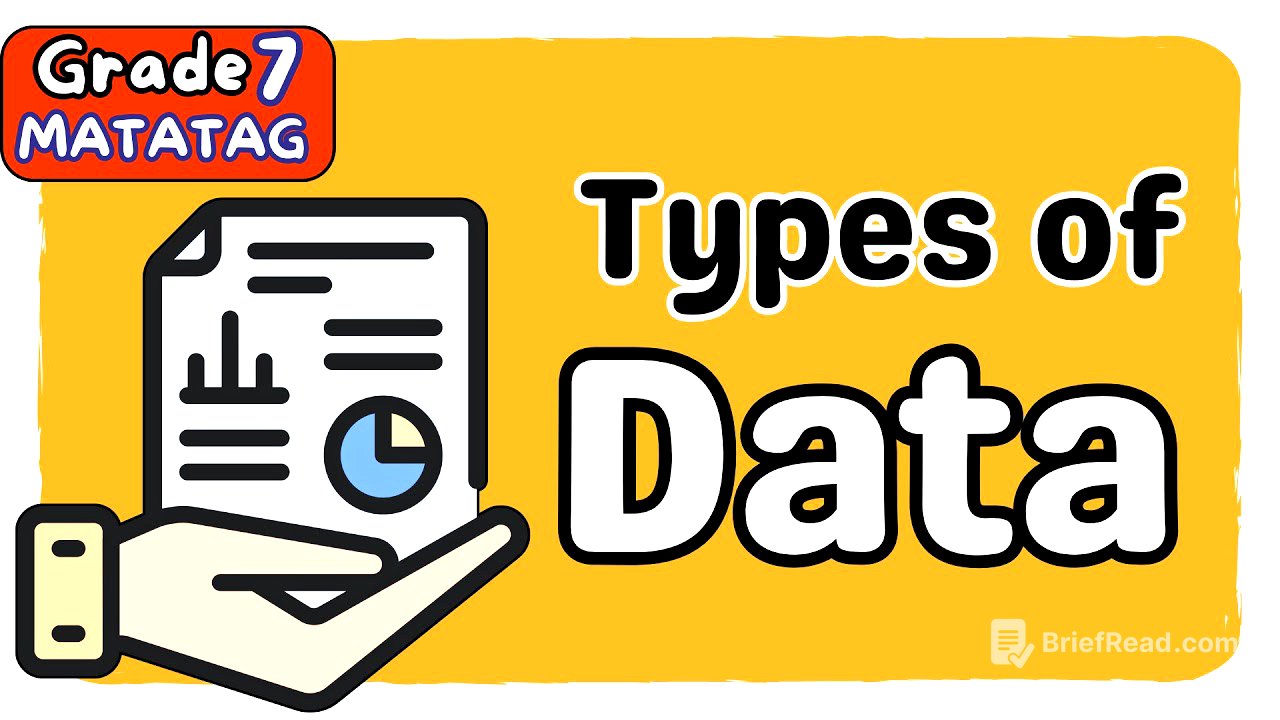TLDR;
This video introduces the fundamental concepts of data in statistics, explaining its importance and different types. It covers the definition of data, its significance in decision-making, pattern recognition, ensuring fairness, problem-solving, and its widespread use across various fields. The video also differentiates between qualitative and quantitative data, along with their subtypes: nominal, ordinal, discrete, and continuous data, providing examples and exercises to enhance understanding.
- Data is crucial for informed decision-making and problem-solving.
- Qualitative and quantitative data are the two main types, each with distinct subtypes.
- Understanding data types is essential for statistical analysis and interpretation.
Introduction: Focus Questions on Data [0:40]
The video starts by posing questions to prompt viewers to consider their experiences with data. These questions include tracking grades, determining popular themes for events, and understanding how companies identify popular products or how YouTube recommends videos. These scenarios highlight the relevance of data collection and analysis in everyday life and various sectors.
What is Statistics and Data? [2:59]
Statistics is defined as a branch of mathematics focused on collecting, organizing, analyzing, and interpreting data to facilitate informed decision-making. Data refers to information, such as facts and numbers, used to analyze situations or make decisions. It can include numbers, words, measurements, or observations, and is used to gain insights, answer questions, or solve problems. Examples from a classroom setting, like student attendance and scores, illustrate how data is collected, analyzed, and used to make decisions about student progress and interventions.
Importance of Data [5:25]
Data is important because it helps in making informed decisions by providing necessary information, as exemplified by weather forecasts from PAGASA, which help people plan their activities based on collected data like rainfall, temperature, and wind conditions. Data also reveals patterns and trends, such as a sports team improving performance through specific training routines by tracking scores. It supports fairness and accuracy by helping to avoid fake news through fact-checking using legitimate surveys and official reports. Furthermore, data aids in solving problems, like using traffic data to decide where to build new roads to reduce congestion. Lastly, data is used everywhere, from hospitals using medical data for diagnoses to companies using sales data to improve products.
Types of Data: Qualitative vs. Quantitative [11:46]
The video explains the two main types of data: qualitative and quantitative. Qualitative data describes qualities or characteristics that cannot be measured numerically, answering questions like "what kind" or "which type." Examples include favorite colors, types of pets, and levels of satisfaction. Quantitative data represents amounts that can be measured or counted, answering questions like "how many" or "how much," and includes things like age, height, and temperature. An exercise is provided to differentiate between qualitative and quantitative data through various scenarios.
Subtypes of Qualitative Data: Nominal and Ordinal [16:03]
Under qualitative data, two subtypes are discussed: nominal and ordinal. Nominal data includes labels or names with no specific order, such as colors (red, blue, green) or types of fruits (apple, orange, banana). Ordinal data, on the other hand, involves categories with a meaningful order or ranking, but the differences between categories are not measurable. Examples include customer satisfaction levels (satisfied, neutral, dissatisfied) and clothing sizes (small, medium, large).
Subtypes of Quantitative Data: Discrete and Continuous [16:33]
The video details two subcategories of quantitative data: discrete and continuous. Discrete data consists of countable, distinct values, often whole numbers, such as the number of students in a class or the number of questions in an exam. Continuous data can take any value within a range and often involves measurements, including fractions or decimals, such as the height or weight of students, or temperatures.
Activity: Identifying Data Subtypes [22:23]
An activity is presented to test the viewer's understanding of the data subtypes: nominal, ordinal, discrete, and continuous. Scenarios are given, such as identifying blood types, finishing positions in a race, and measuring the height of students, and viewers are asked to classify each scenario into the appropriate data subtype. The answers are then provided to allow viewers to check their understanding.









